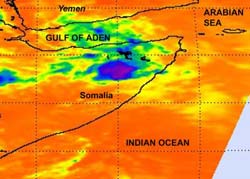Bandu begone: Tropical Cyclone 2A fading in Somalia

On May 22 at 22:29 UTC (6:29 p.m. EDT) NASA\'s Atmospheric Infrared Sounder flying aboard the NASA Aqua satellite captured a small area of cold clouds (blue) associated the remnants of Bandu. Credit: NASA JPL, Ed Olsen<br>
Before 24 hours had elapsed, Bandu had already dissipated because of cooler waters, higher wind shear and drier air in the Gulf of Aden. It curved southwest and made landfall in northeast Somalia. On May 22 at 22:29 UTC (6:29 p.m. EDT) NASA's Atmospheric Infrared Sounder (AIRS) flying aboard the NASA Aqua satellite captured a small area of cold clouds associated the remnants of Bandu. AIRS measures cloud-top temperatures and noticed the remnants over the Sool and Puntland regions of Somalia.
On Monday, May 24, the remnants of Bandu were still bringing showers to northeastern Somalia. Forecasts for the cities of Garowe and Las Anod call for widely scattered showers and thunderstorms with temperatures in the low 80s (Fahrenheit) as Bandu's remnants continue to dissipate. Garowe is the capital city of the Puntland administrative region of Somalia. Las Anod is the administrative capital of Sool region of Somalia.
Media Contact
More Information:
http://www.nasa.govAll latest news from the category: Earth Sciences
Earth Sciences (also referred to as Geosciences), which deals with basic issues surrounding our planet, plays a vital role in the area of energy and raw materials supply.
Earth Sciences comprises subjects such as geology, geography, geological informatics, paleontology, mineralogy, petrography, crystallography, geophysics, geodesy, glaciology, cartography, photogrammetry, meteorology and seismology, early-warning systems, earthquake research and polar research.
Newest articles

Bringing bio-inspired robots to life
Nebraska researcher Eric Markvicka gets NSF CAREER Award to pursue manufacture of novel materials for soft robotics and stretchable electronics. Engineers are increasingly eager to develop robots that mimic the…

Bella moths use poison to attract mates
Scientists are closer to finding out how. Pyrrolizidine alkaloids are as bitter and toxic as they are hard to pronounce. They’re produced by several different types of plants and are…

AI tool creates ‘synthetic’ images of cells
…for enhanced microscopy analysis. Observing individual cells through microscopes can reveal a range of important cell biological phenomena that frequently play a role in human diseases, but the process of…





















